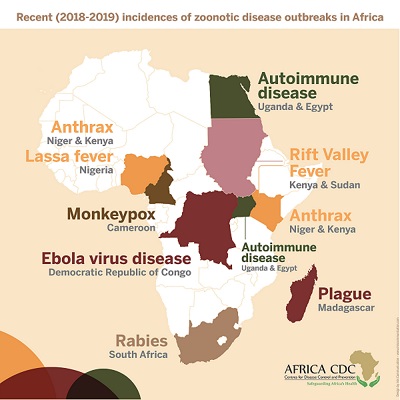Recent health emergencies such as the Covid-19 pandemic, monkey pox and ebola have heightened concerns over risks of increasing zoonotic disease spillover arising from environmental degradation and climate change, prompting health agencies to rethink health systems.
In particular, health experts point to the growing threat of diseases jumping from animals to humans – zoonoses – across parts of Africa as urbanization, travel and deforestation, among other factors increasingly see people encroach on wildlife reserves.
According to Africa CDC, the African Union public health agency supporting member States to deal with disease outbreaks, recurrent adverse events linked to the warming of the planet have also fueled growing threat of antimicrobial resistance (AMR) and food safety problems, among other health concerns that call for holistic response strategy.
Also read: KASEYA: Vaccinating your dog, cat could keep next pandemic at bay
According to the agency, parts of the continent are battling these threats at the same time, and climate change continues to exacerbate their toll, necessitating a shift to the approach that factors in the human-animal-environment nexus. The latter is also known as One Health.
“These shared health threats at the human-animal-environment nexus are complex, and it’s important that we understand that a single approach or perspective cannot address them. Addressing these issues require a multi-sectoral, multidisciplinary approach, but beyond that it’s important that countries and regions really work together to effectively detect, monitor, prevent and control shared health threats,” says Dr. Yewande Alimi who is One Health Lead at Africa CDC.
These shared health threats at the human-animal-environment nexus are complex, and it’s important that we understand that a single approach or perspective cannot address them.
Dr. Yewande Alimi, One Health Unit Lead, Africa CDC
Growing risk
In her view, countries on the continent need a fully operational One Health approach as cost-effective mechanism to tackle rising threats of zoonotic diseases, AMR, food safety and climate change. “Effective collaboration, timely communication and most importantly improved coordination across sectors will help us achieve a safer and healthier Africa,” she said.
More than 75 percent of disease outbreaks recorded over the recent past are of zoonotic origin, according to Africa CDC, highlighting the new growing risk with studies suggesting that the next pandemic will most likely originate from animals.
Also on the rise are incidences of antimicrobial resistance, the situation when bacteria or virus no longer respond to drugs that used to kill them, putting many more Africans at risk.
“Across 14 countries in the recent data published by Africa CDC, we are already seeing more than 50 per cent drug resistance index. This is really concerning because it means that if nothing is done, if no interventions are in place, we stand the chance to lose the benefit of antimicrobials such as antibiotics, antivirals or antifungals that are developed to treat infections,” Alimi told NewsPaper Africa.
With AMR, you could get a simple bite or a small cut which could get infected and it could result in severe illness or even death because antibiotics don’t work. Health experts are concerned that, if unchecked, this could foment a disaster for everyone and especially people with underlying health conditions and children.
Also read: Fighting lies about vaccines and the harm they cause: Experts’ take
INTERVIEW EXCERPTS:

So in light of these health threats, what needs to change in people’s relationships with animals?
Yewande: Interacting properly with animals, wildlife, livestock and pets can help reduce outbreaks of these diseases. For example, when you go to the bushes and eat bush meat not properly handled or cooked you are more at risk to zoonotic diseases.
Cutting trees or destroying the forests, safaris, the environment, all that affects how zoonotic diseases are spread, the more we interact with wild animals, we are increasing that risk of transmission of diseases from animals.
It is equally important to routinely vaccinate animals, your pets and livestock as it is an effective intervention to reducing potential disease outbreaks in any population. If you have animals, either your cat or your dog it’s your responsibility to ensure that they get routine vaccinations.
It always important for either a pet owner, a livestock owner or a farmer to ensure that medications be it vaccinations or drugs are done by a trained veterinarian.
Farmers need to pay attention to biosecurity, meaning keeping the farms clean to reduce spread of infection from one farm to another or from farmers to other farmers.

How is Africa CDC supporting One Health approach, and particularly diagnostic capacity for zoonotic diseases outbreak across the continent?
Yewande: Your question about diagnostic capacity is very crucial because the stronger diagnostic capacity we have across the continent we are able to ensure that we have timely or early detection of diseases, we are able to ensure that we have strong surveillance systems in place, and most importantly, it can guide disease outbreak response activities.
Africa CDC is supporting strategic collaboration from the animal, human and environmental health sectors at national, regional and continental level to ensure One Health approach for zoonotic disease control and prevention.
One of the examples I would like to highlight of the benefits of One Health approach was during the Covid-19 pandemic: Countries did not have enough laboratory and diagnostic capacity, and you may remember that testing was very crucial.
So, many countries explored shared laboratory resources across sectors. For instance, for Covid-19 testing, many countries were using the veterinary laboratories to scale up testing capacity and an effective response.
We have also seen how countries work together to ensure joint diseases investigation, risk communication and sharing of their resources. When you think about antimicrobial resistance, one of the things that we are trying to champion at Africa CDC is stronger laboratory systems and network across different sectors to ensure that we have stronger AMR testing capacity within our countries.
Through our Regional Integrated Surveillance and Laboratory Network, and PGI we are now helping countries to ensure that there is easier sample referral mechanism so that countries can send sample to other countries to isolate, identify and subsequently the findings are shared with the countries.
~ BIO: Dr. Yewande Alimi (DVM, MPH) is the One Health Unit Lead at Africa CDC, and co-lead for the African Union Task force on AMR. She has been at the forefront of developing and implementing comprehensive strategies that bridge the gap between human, animal, and environmental health. She leads the implementation of several strategies including the Africa Union Framework for AMR Control in Africa Union and the Africa CDC’s Framework for One Health Practice for NPHIs in member States.





